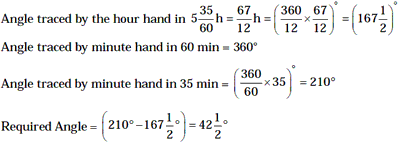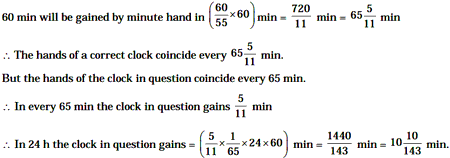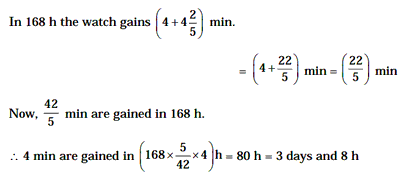(HOT) UPSC Current Affairs 2025 PDF
NEW! The Gist (OCT-2025) | E-BOOKS
(Online Course) CSAT Paper - II : Basic Numeracy: Clocks & Calendar
Basic Numeracy
Clocks & Calendar
Clock
A clock has 2 hands, the smaller one is called the hour hand or short hand while the larger one is called the minute hand or long hand. The face of a clock is a circle which subtends an angle of 360° at the centre.
Some Important Points:
In every hour
1. (a) Both the I ands coincide once. At this point the angle between
them is 0°..
(b) The hands are straight (point in opposite directions) once. At this
point the angles between them are 180°.
(c) The hands are twice perpendicular to each other. At this point the
angle between them is 90°.
2. (a) In 60 min the minute hand covers 360°.

3. (a) When the two hands are at right angles, they are 15min spaces
apart.
(b) When the two hands are in opposite directions, they are 30 min spaces
apart.
(c) In 60 min the minute hand gains 55 min on the hour hand.
(d) The minute hand moves 12 times as fast as the hour hand.
4. (a) Too Fast: If a clock indicates 7 : 1.5, when the correct time
is 7, it is said to be 15 min too fast.
(b) Too Slow: If a clock indicates 7 : 30, when the correct time is 7 45
, it is said to be 15 min too slow.
Calendar
1. Odd Days: The number of days more than the complete weeks for a given period called odd days.
2. Ordinary Year: An ordinary year has 365 days and an ordinary year is not a leap year.
3. Leap Year:
(a) Any year (except a century) which is divisible by 4 is a leap
year.
(b) However, every 4th century is a leap year, ie, a century is a leap
year when it is divisible by 400.
(c) A leap year has 366 days.
Examples of Leap Year 1924, 1908, 1944, 2008, 1684, etc., are all leap years. 400, 800, 1200, 1600, 2000, etc., are all leap years.
4. Counting of Odd Days
(a) 1 ordinary year = 365 days = (52 weeks + 1 day) Þ 1 ordinary year = 1
odd day
(b) 1 leap year = 366 days = (52 weeks + 2 days) = 1 leap year = 2 odd
days
(c) 100 yr = 76 ordinary years + 24 leap years = (76 × 1 + 24 × 2) odd
days = 124 odd days = (17 weeks + 5 days) = 5 odd days
(d) 200 yr = (5 × 2) = 10 odd days = (1 week + 3 days) = 3 odd day
(e) 300 yr = (5 × 3) = 15 odd days = (2 weeks + 1 day) = 1 odd days
(f) 400 yr = (5 × 4 + 1) = 21 odd days = (3 weeks + 0 day) = 0 odd .lay
Similarly, 800 yr, 1200 yr, 1600 yr, 2000 yr have 0 odd days.
5. Day of the week with respect to the number of odd days
| Number of odd days | Day of the week |
| 0 | Sunday |
| 1 | Monday |
| 2 | Tuesday |
| 3 | Wednesday |
| 4 | Thursday |
| 5 | Friday |
| 6 | Saturday |
Example 1: Find the angle between the hour hand and the minute hand of
a clock when the time is 5 : 35.
Solution. Angle traced by hour hand in 12 h = 360°

Example 2: At what time between 8 and 9 O’clock will the hands of a
clock be in the same straight line but not together ?
Solution. At 8 O’clock the hour hand is at 8 and the minute hand is at
12. Thus, the two hands are 20 min spaces apart. To be in the same straight line
but not together, they will be 30 min spaces apart. .% he minute hand will gain
(30 – 20) min = 10 min spaces over the hour hand. 55 min spaces are gained by
hour hand in 60 min.
10 min spaces will be gained by hour hand in 60 × 10 min = 120/11 min
The hands will be in the same straight line but not together at 120/11 pest 8.
Example 3: If the hands of a clock coincide every 65min (true time) in
24 h. How much a day does the clock gain ?
Solution. 55 rain are gained by mintue hand in 60 min.

Example 4: A watch which gains uniformly is 4 min slow at 7 pm on Mo
day and is 4 min 48 s fast at 7 pm on following Monday. When was the watch
correct ?
Solution. Total time in hours from Monday at 7 pm to the following Monday
at 7 pm = (7 × 241, h = 168h.

Example 5: A clock gains 10min in every 24 h. It is set , ht on Tuesday
at 9 am.Whet will be the correct time on the following Thursday, when the watch
indicates 7 pm.
Solution. Time from Tuesday at 9 am to the following Thursday at 7 pm =
(24 × 2 + 10) h = 58h 24 h 10 min of the clock in question = 24 h of the correct
clock h of the clock in question = 24 h of the correct clock 40 h of the clock
in question = (24 × 6/145 ×58 )h of the correct clock = 57 h 36min of correct
clock The correct time is 57 h 36 ml after 9 am on Tuesday Thus, the correct
time on the following Wednesday will be 6 : 36 pm.
Example 6: What was the day of the week on 26th June, 1816 ?
Solution. 26th June 1816 = (1815 yr + Period from 1.1.1816 to 26.6.1816)
counting of odd days
Number of odd days in 1600 yr = 0
Number of odd days in 200 yr = 3
15 yr = 3 leap years + 12 ordinary years = (3 × 2 + 12 × 1) odd days = 18 odd
days (2 weeks + 4 days) = 4 odd days
1815 have = (0 + 3 + 4) = 7 odd days = 0 odd day
Jan Feb March April May June
(31 + 29 + 31 + 30 + 31 + 261=178 days 178 days = (25 weeks + 3 days) = 3 odd
days
Total number of odd days = (0 + 3) = 3 odd days Hence, the required Jay is
Wednesday.
